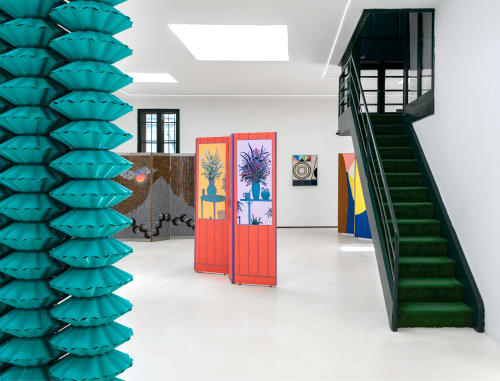Hidden memories
The exhibition Hidden memories unites the work of four artists; Thomas Grünfeld, Gregor Hildebrandt, John McAllister and Claudia Wieser, all working originally in different media, in the theme of the folding screen. Materials such as felt, wood, paper, canvas and vinyl records come together in the screens and are in direct dialog with smaller works by the individual artists that correspond in form or content.
In John McAllister's work, the term folding screen refers to his experimental pieces in the field of tension between painting and three-dimensional object. McAllister folds space, depth and image into his folding screens; his paintings often show interiors or excerpts from landscapes, framed by geometric or floral patterns. In the exhibition, arranged flower-vase still lifes of an 'untamed' nature merge on one and the same object, and also let the viewer wander through the different seasons.
Gregor Hildebrandt reshapes records, for instance by heating them, into convex bowls-like shapes or hemispheres, which he then stacks into columns or walls, so-called 'sound walls', or 'sound barriers'. These large-scale sculptures consist of countless records and divide spaces both visibly and symbolically. For the exhibition in Venice, Gregor Hildebrandt has assembled records in turquoise – color of the lagoon – into a large-scale wave-shaped wall installation that redefines the natural flow of visitors through the exhibition.
Thomas Grünfeld’s folding screens are more than room dividers: they are artful objects that deceive function and design, dematerialize familiar forms and compel us to pause. His Doggy (folding screen) is a key work that concentrates his questioning of purpose, material and furniture aesthetics. Grünfeld first designs the piece as an apparently functional room divider, but on closer inspection, its 'dysfunctional', purely artistic nature becomes evident, as the familiar folding screen format is deconstructed. As with much of Grünfeld’s work, this piece is also based on a fusion - here it is the unusual mix of materials (felt, wood, veneer) that transforms the pragmatic folding screen into 'false piece of furniture'. The title, Doggy, explores the space between sympathy and irritation, an aesthetic ambiguity that questions the everyday.
Claudia Wieser creates sculptures, wall installations and tapestries based on the principle of geometric abstraction. Her installations are often large-scale, and her art stands in a reflective relationship to furniture. She quotes their form, function and position in space, without actually designing furniture herself. On the folding screen in the exhibition, a space behind the space appears to open at first glance, only to be drawn back into one and the same abstract pictorial plane. The play with supposed perspectives takes place on various papers that interweave and become a kind of architectural landscape on the folding screen.









